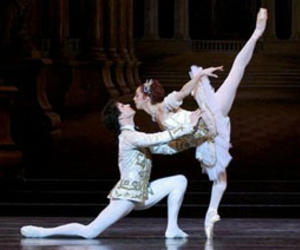Cubans fast becoming the new stars in ballet
- Submitted by: manso
- Editorial Articles
- 01 / 26 / 2011

By SIGAL RATNER-ARIAS, AP Entertainment Writer. AP. In this undated publicity image released by the Boston Ballet, Cuban dancers Nelson Madrigal, left, and his wife Lorna Feijoo perform in "The Sleeping Beauty" at the Wang Center for the Performing Arts in Boston. (AP Photo/Boston Ballet,Angela Sterling)
NEW YORK — Their technique is impeccable, their passion incomparable.With flare and unique style, Cuban dancers are climbing to stardom in American companies from American Ballet Theatre in New York to the Boston and the San Francisco Ballets, and are widely considered the new Russians of ballet.
"It's impossible not to notice when a Cuban dancer walks into the studio," Mikhail Baryshnikov notes in the prologue to "Cuban Ballet," a book by art critic Octavio Roca.
"It's been said before that no one is born a dancer; you have to want it more than anything. These Cubans want it and feel privileged to be a part of it. They give themselves completely," says Baryshnikov, who defected from the then Soviet Union's Kirov Ballet in 1974 to become one of the greatest dancers of the 20th century. He was part of a wave of Russian talent that included another ballet great, Rudolf Nureyev.
Two stars of Cuban ballet, sisters Lorna and Lorena Feijoo, adorn the cover of Roca's book, which explores the history of the Cuban ballet by focusing on Alicia Alonso, a prima ballerina assoluta (the highest honor in dance) and founder of the National Ballet of Cuba.
"Cubans are dancing people. Dance matters to us, and it matters deeply," says Alonso, who at 90 and partly blind remains at the helm of her company.
"I think that what Alicia has created in Cuba is a real miracle," says Jose Manuel Carreno, who retires as a principal dancer at ABT in August. "A dancer in Cuba is as recognized as any athlete in the United States and that is sincerely something you don't see anywhere else."
"Cuban Ballet" is beautifully illustrated and features many young dancers who "are changing the face of ballet with their superb technique, impeccable work ethic, and spectacular performances." Besides the Feijoo sisters, the book notes Joan Boada, Taras Domitro, Manuel Carre, Rolando Sarabia and Carlos Acosta, among others.
"The interesting thing about the Cuban ballet is that the whole population of Cuba could fit in New York ... and yet the influence of that island in the arts, and especially in dance, is a miracle that I want to celebrate," Roca says.
"The history of the Cuban ballet is a story of hope and triumph."
The influence that Russia had on international ballet is obvious even in the Cuban ballet. What makes the island's dancers different seem to be a combination of a strict, integral education from a young age, an exposure to a very particular audience, a promotion of the arts comparable with that of the sports in other countries.Like Russian dancers, training for Cuban dancers is very strict.
"Our education is completely integral: You get French because the steps are taught in French; you get piano; you get history ... and if you don't pass any given subject, you don't go to the next level," said Lorna Feijoo, 36, principal dancer at the Boston Ballet. It is a very strict school."
Feijoo, who started dancing when she was 10, was a prima ballerina of the National Ballet of Cuba. She said that of the 500 dancers who audition each year, only 15 are chosen.
"Cuban dancers are extraordinarily well trained and well educated as artists, not as dancer machines," said Suki John, a dance writer and teacher in Fort Worth, Texas, who has worked with Cuban dancers since 1992.
"They are exposed to many cultural aspects. They study Cuban modern dance, social dance. ... They are very well versed in the language of the body, which gives them an incredible sensibility that gives warmth to the audience."
Mikko Nissinen, artistic director of the Boston Ballet, says he can often identify a Cuban dancer in a performance.
"There are certain stylistic things, certain manners, how the men approach the preparation for the turn. ... I can pretty much say they've been trained in Cuba," he says. "Cuban dancers have a very good ... command on the technique."
But with all the good training also comes a talent drain, as dancers leave Cuba to learn other forms of dance that don't make it to the island.
"It is painful," Alonso once said in an interview with The Associated Press. "They have received an education of more than nine years, for free."
The dancers say they feel very grateful for what Cuba has given them, but that leaving the island was their only choice if they wanted to keep growing as artists.
"Even though the school is very good, there are moments where you find yourself stuck - you want to know what's going on in other parts of the world, have the freedom to manage your career as an adult and incursion in other styles," Lorena Feijoo says.
"The (Cuban) ballet in itself has integrity, is no propaganda," says author Roco. "You go to see 'Swan Lake,' 'Giselle,' 'Don Quixote.' What it doesn't have is modern, contemporary ballet. ... That is one of the reasons, why many dancers leave; they want to dance other things." The Associated Press
Source: www.signonsandiego.com/news/2011/jan/25/cubans-fast-becoming-the-new-sta...
Comments